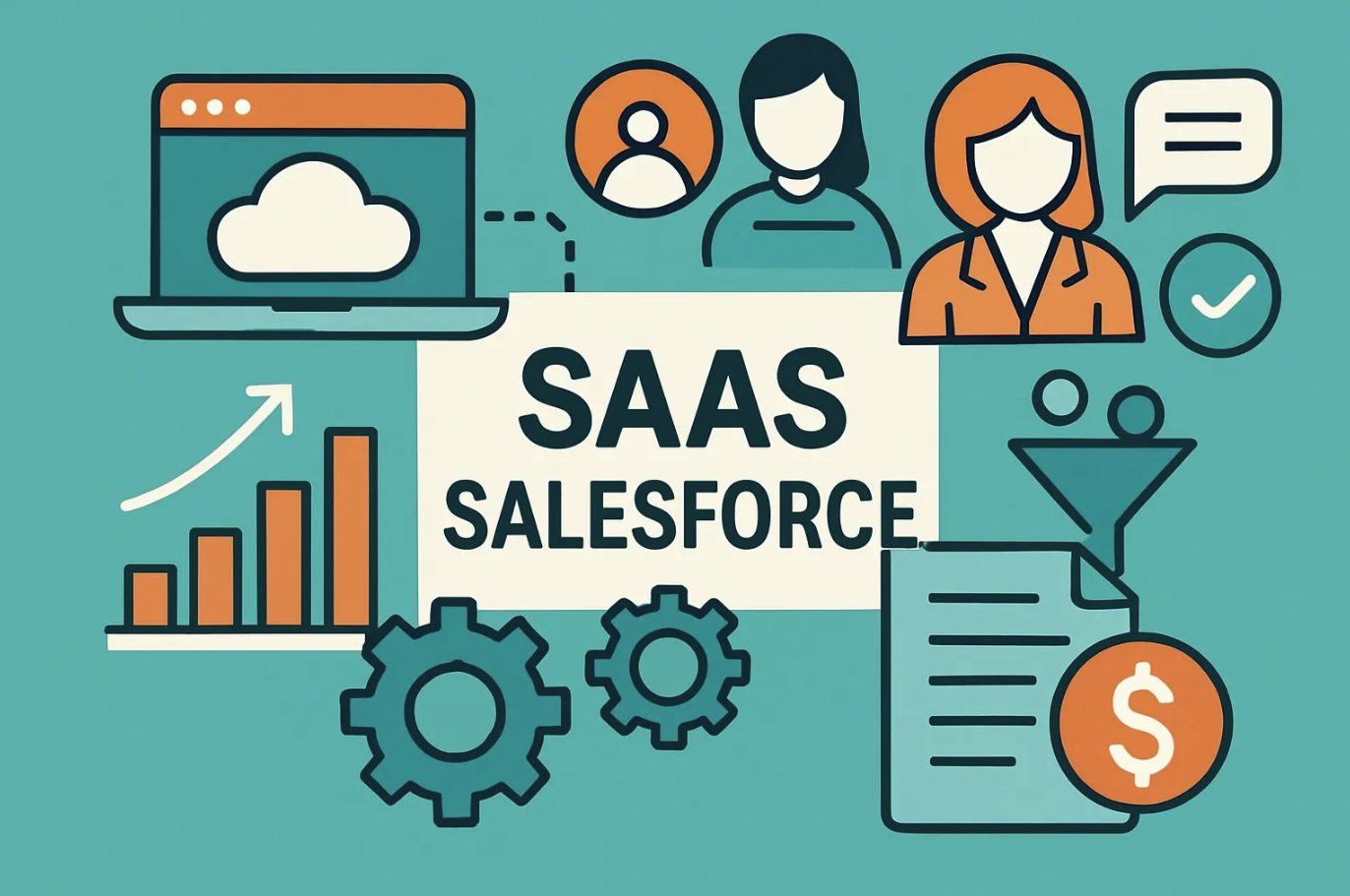
Return on investment (ROI) determines the success of SaaS businesses, particularly in the context of SaaS Salesforce. It reflects the impact of every dollar spent and highlights the efficiency of operations. In 2025, SaaS companies face growing competition and the need for strategic investments. As IT spending is expected to increase by 9.3%, totaling $5.74 trillion worldwide, companies need to prioritize enhancing ROI. Out of this amount, $1.7 trillion will be allocated to software, highlighting the significance of tools such as SaaS Salesforce.
SaaS Salesforce transforms customer engagement, optimizes workflows, and drives growth. Its capabilities empower businesses to retain customers, enhance efficiency, and deliver personalized experiences, representing a pathway to sustainable success.
Challenges in SaaS Sales and ROI Maximization
Customer churn and retention struggles
Customer churn remains one of the most pressing challenges for SaaS businesses. Losing customers not only impacts revenue but also disrupts growth momentum. Studies show that customer churn can disproportionately affect revenue when high-value clients are lost. For instance, while losing smaller customers may seem manageable, losing a single high-value client can feel like losing a whale in a sea of small fish. This highlights the importance of focusing on retention strategies that prioritize high-value customers.
Retention struggles often stem from unmet expectations or a lack of engagement. SaaS companies must ensure their value proposition aligns with customer needs. Tools like Salesforce can help businesses track customer interactions and identify churn risks early. By leveraging CRM capabilities, SaaS businesses can create personalized experiences that foster loyalty and reduce churn rates.
Inefficiencies in lead generation and sales processes
Lead generation inefficiencies can hinder SaaS sales growth. Metrics like cost per lead (CPL) and lead conversion rates reveal how well businesses attract and convert potential customers. However, many SaaS companies struggle to optimize these metrics due to market saturation and competition. For example, increased competition often drives up customer acquisition costs (CAC), making it harder to achieve sustainable growth.
Sales processes also face challenges like longer sales cycles and misaligned strategies between sales and marketing teams. Outsourced lead generation has proven to deliver 43% better results than in-house efforts, emphasizing the need for effective strategies. Platforms like Salesforce streamline lead management and sales processes, enabling teams to focus on high-priority leads and improve pipeline velocity.
Limited actionable insights from data
Data is a goldmine for SaaS businesses, but extracting actionable insights can be challenging. Common pitfalls include overlooking context, confirmation bias, and misjudging data relevance. These issues can lead to misguided decisions that hinder growth.
SaaS companies need tools that provide clarity and relevance in data analysis.
The Salesforce platform offers AI-driven analytics that help businesses interpret data effectively. SaaS companies can make informed decisions that create value by analyzing previous client interactions and market trends. This ability is essential for effectively navigating the complexities of SaaS sales and enhancing ROI.
Balancing scalability with personalization
SaaS businesses often face a critical challenge: scaling operations while maintaining a personalized customer experience. As companies grow, the need to cater to a diverse customer base increases. However, delivering tailored experiences at scale can strain resources and complicate workflows. This balancing act becomes even more crucial in 2025, where customer expectations for personalization are at an all-time high.
Customization in SaaS enhances user satisfaction and operational efficiency. Yet, it introduces challenges like integration difficulties and maintenance complexity.
Businesses must adopt strategies to scale without compromising their value proposition. One effective approach involves leveraging the Salesforce platform to automate routine tasks. This enables customer success managers to focus on high-impact activities, such as nurturing relationships with high-value customers.
Customer segmentation is a potent strategy. By categorizing customers according to common traits, SaaS companies can deliver contextual experiences that provide personalization at scale. For instance, a B2B SaaS company might differentiate leads by industry or company size, customizing its sales process and messaging to target particular pain points. Salesforce is a leader in this domain, providing tools that combine CRM data with sophisticated analytics to yield actionable insights.
The use of cloud-based platforms further simplifies scalability. These platforms provide the flexibility needed to adapt to changing customer demands while maintaining a consistent level of service. Salesforce’s seamless integration capabilities allow SaaS businesses to connect their CRM with other tools in their ecosystem, ensuring a unified approach to customer engagement.
Salesforce Solutions for SaaS Businesses
CRM tools for improving customer retention
Customer retention is a cornerstone of success for SaaS businesses. Salesforce offers robust customer relationship management tools that empower companies to build long-term relationships. These tools help businesses track interactions, monitor satisfaction, and identify potential churn risks.
For SaaS companies, this means creating a seamless experience that aligns with their value proposition.
Research shows that businesses using CRM systems experience a 50% increase in customer retention rates. Additionally, they report a 41% boost in sales revenue and a 32% reduction in marketing costs. These metrics highlight the transformative power of CRM tools in driving retention and revenue growth. Salesforce’s Sales Cloud and Service Cloud provide tailored solutions for managing customer data, enabling SaaS companies to deliver personalized experiences at scale.
Salesforce also supports proactive engagement through automated alerts and notifications. For example, overdue invoice reminders or renewal alerts can enhance financial management and improve customer satisfaction. These features ensure that SaaS businesses stay ahead of customer needs, fostering loyalty and trust.
Workflow automation for sales efficiency
Efficiency is critical in SaaS sales, where competition is fierce, and time is valuable. Salesforce’s workflow automation tools streamline repetitive tasks, allowing sales teams to focus on high-value activities. Automation ensures cleaner company data, improved lead nurturing, and increased conversion rates.
For instance, predictive lead scoring identifies promising leads, enabling sales teams to prioritize their efforts. Automation also personalizes email campaigns and follow-ups, guiding leads through the sales cycle precisely.
Studies reveal that 73% of IT leaders attribute significant time savings to automation, while 90% of executives expect it to enhance workforce capacity.
The Salesforce platform integrates seamlessly with existing SaaS ecosystems, ensuring a unified approach to sales operations. This integration reduces manual errors and accelerates processes, boosting efficiency and profitability.
|
Benefit |
Description |
|---|---|
|
Cleaner Data |
Access to accurate, up-to-date information for streamlined operations. |
|
Improved Lead Nurturing |
Personalized campaigns and follow-ups that guide leads effectively. |
|
Increased Conversion Rates |
Focused efforts on high-potential leads through predictive scoring. |
AI-driven analytics for better decision-making
Data-driven decision-making is essential for SaaS businesses aiming to stay competitive. Salesforce leverages AI-driven analytics to transform raw data into actionable insights. These tools analyze large data volumes, identify patterns, and accurately predict future trends.
Generative AI within Salesforce enables SaaS companies to anticipate market shifts and customer needs. For example, AI-powered anomaly detection identifies unusual patterns in real-time, helping businesses mitigate risks. By 2025, over 60% of SaaS companies are expected to rely on AI for predictive analytics, underscoring its growing importance. AI also enhances marketing strategies and customer service by providing precise insights.
SaaS businesses can use these insights to refine their approaches, ensuring they deliver maximum customer value. The Salesforce platform’s AI capabilities empower companies to make informed decisions, driving growth and innovation.
Seamless integration with SaaS ecosystems
Seamless integration within SaaS ecosystems has become a cornerstone for success in 2025. As SaaS businesses expand their operations, the ability to connect various software tools and platforms becomes essential for maintaining efficiency and driving growth. Salesforce excels in this area, offering robust integration capabilities that empower businesses to unify their workflows and enhance productivity.
One of the most significant advantages of Salesforce lies in its ability to integrate with a wide range of SaaS applications. This includes marketing automation tools like Pardot and Marketo, collaboration platforms such as Slack, and customer service solutions. These integrations ensure that data flows effortlessly between systems, eliminating manual processes and reducing errors.
For example, integrating Salesforce with Slack enables real-time communication among sales teams, fostering collaboration and accelerating decision-making.
The Salesforce platform also supports advanced data management through features like API integration, data mapping, and ETL/ELT processes. These tools ensure that data remains consistent and accurate across all connected systems. Cloud-based integration platforms (iPaaS) further simplify this process by centralizing the management of various SaaS applications. This streamlined approach saves time, enhances data accuracy, and provides deeper insights into customer behavior.
|
Feature/Report |
Overview |
Benefits for SaaS |
|---|---|---|
|
Customizable Dashboard and Reporting Tools |
Highly customizable dashboards for real-time data visualization. |
|
|
Integration with Marketing Automation |
Seamless integration with platforms like Pardot and Marketo. |
Aligns sales and marketing efforts. |
|
Collaboration Tools (Slack Integration) |
Enhances team collaboration through Slack. |
Facilitates real-time communication among sales teams. |
|
Sales Pipeline and Forecasting Reports |
Tracks the health of the sales pipeline. |
Key metrics include pipeline stages and win rates. |
|
Customer Acquisition and Churn Reports |
Understands new customer acquisition versus churn. |
Key metrics include acquisition costs and churn rate. |
Seamless integration not only improves operational efficiency but also enhances the customer experience. Businesses can deliver personalized interactions that align with their value proposition by automating workflows and providing employees with immediate access to critical information. This approach boosts customer satisfaction and loyalty, ultimately driving revenue growth.
Measuring ROI with Salesforce
Key metrics like CLTV and LVR
Measuring ROI effectively begins with tracking the right metrics. Customer Lifetime Value (CLTV) and Lead Velocity Rate (LVR) stand out as essential indicators for SaaS businesses. CLTV measures a customer’s total revenue over their lifetime, helping businesses identify high-value segments. Salesforce enables SaaS companies to analyze CLTV by integrating customer data and purchase history into actionable insights.
This approach not only boosts revenue but also enhances customer satisfaction and retention.
LVR, on the other hand, evaluates the growth rate of qualified leads month-over-month. It provides a clear picture of sales pipeline health and future growth potential. Salesforce’s lead management tools streamline this process by automating lead tracking and scoring. Businesses can use these insights to refine their sales strategies and focus on high-conversion opportunities.
|
Metric |
Description |
Formula |
|---|---|---|
|
Customer Lifetime Value (CLTV) |
Measures total revenue expected from a customer over their lifetime. |
CLTV = Average Purchase Value × Average Purchase Frequency × Customer Lifespan |
|
Lead Velocity Rate (LVR) |
Tracks the growth rate of qualified leads month-over-month. |
LVR = ((Current Month’s Qualified Leads – Previous Month’s Qualified Leads) / Previous Month’s Qualified Leads) * 100 |
Tracking MRR growth and customer satisfaction
Monthly recurring revenue (MRR) serves as a cornerstone for SaaS success. It reflects the stability and growth of subscription-based revenue streams. Salesforce’s subscription management tools allow businesses to monitor MRR trends in real time. This visibility helps identify opportunities for upselling and cross-selling, driving consistent revenue growth.
Customer satisfaction plays a pivotal role in sustaining MRR. Metrics like Net Promoter Score (NPS) and churn rate provide valuable insights into customer loyalty and product performance. Salesforce integrates these metrics into its dashboards, enabling SaaS companies to proactively track satisfaction levels and address pain points.
A focus on customer-centric strategies, as demonstrated by Salesforce’s own 75% gross margin, highlights the importance of aligning satisfaction with revenue goals.
Evaluating retention rates and sales efficiency
Retention rates directly impact SaaS profitability. A 5% improvement in customer retention can increase profits by 25% to 95%. Salesforce equips businesses with tools to evaluate retention through metrics like churn and repeat purchase rates. These insights help identify at-risk customers and implement targeted retention strategies.
Sales efficiency is another critical factor. Metrics such as lead conversion rates and sales cycle length reveal how effectively teams close deals. Salesforce’s automation and AI-driven analytics optimize these processes, reducing manual errors and improving productivity. SaaS companies can maximize ROI and achieve sustainable growth by focusing on retention and efficiency.
Using Salesforce dashboards for real-time insights
Salesforce dashboards empower SaaS businesses to make data-driven decisions with confidence. These dashboards provide a centralized view of critical metrics, enabling teams to monitor real-time performance. With intuitive visualizations, businesses can quickly identify trends, track progress, and respond to challenges.
For SaaS companies, real-time insights are invaluable. They allow teams to track key performance indicators (KPIs) such as monthly recurring revenue (MRR), customer churn rates, and lead conversion rates. Salesforce dashboards simplify this process by presenting data in a clear and actionable format. For example, a SaaS company can use a dashboard to monitor the health of its sales pipeline. This visibility helps sales teams prioritize high-value leads and close deals faster.
Customization is another standout feature of Salesforce dashboards. Businesses can tailor dashboards to align with their unique goals and workflows. A SaaS company focused on customer retention might create a dashboard highlighting renewal rates and customer satisfaction scores. Meanwhile, a team aiming to boost sales efficiency could track average deal size and cycle length metrics. This flexibility ensures that every team member has access to the insights they need to excel.
Collaboration also improves with Salesforce dashboards. Teams can share real-time updates, ensuring everyone stays aligned on objectives. For instance, a marketing team can share campaign performance metrics with the sales team, fostering better coordination. This seamless communication drives efficiency and enhances overall performance.
Accessing real-time insights through Salesforce dashboards gives SaaS businesses a competitive edge. It transforms raw data into actionable strategies, enabling companies to adapt quickly and achieve sustainable growth. In 2025, leveraging these tools will be essential for SaaS companies striving to maximize their ROI.
Salesforce stands as a cornerstone for SaaS growth in 2025, offering tools that empower businesses to thrive in a competitive landscape. Its ability to streamline operations, enhance customer retention, and deliver actionable insights makes it indispensable for SaaS companies aiming to maximize ROI.
Adopting innovative strategies, such as leveraging AI-driven analytics and exploring Salesforce AppExchange, positions businesses for long-term success. Companies that embrace these approaches often experience higher retention rates and revenue growth. For instance, Salesforce’s community engagement initiatives have been shown to reduce churn while boosting annual revenue by 26%.
SaaS businesses that integrate Salesforce into their operations unlock new opportunities for scalability and personalization. This platform not only supports growth but also fosters stronger customer relationships. By embracing Salesforce, companies can secure a competitive edge and achieve sustainable success in the evolving SaaS industry.



